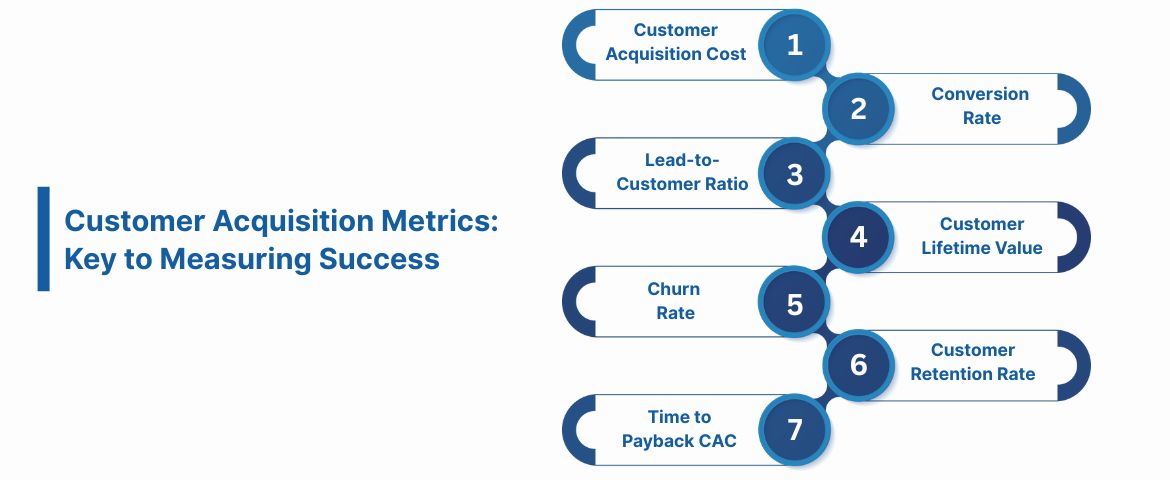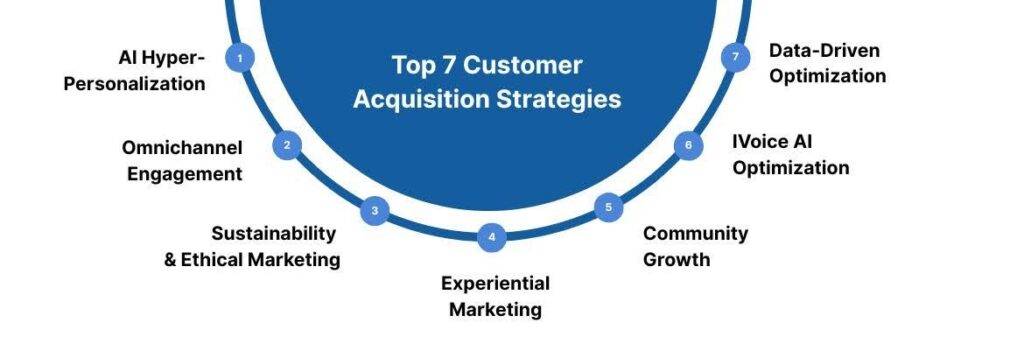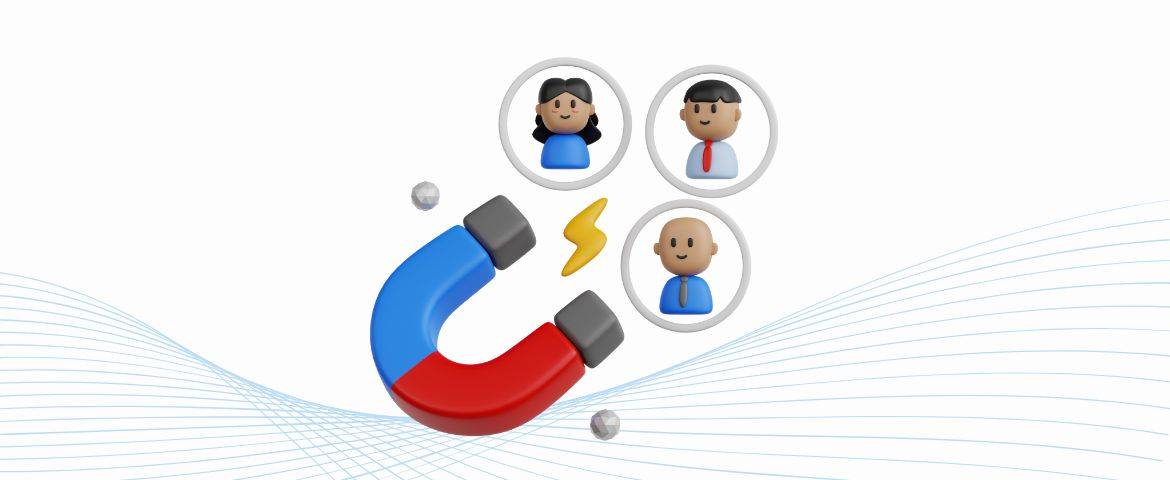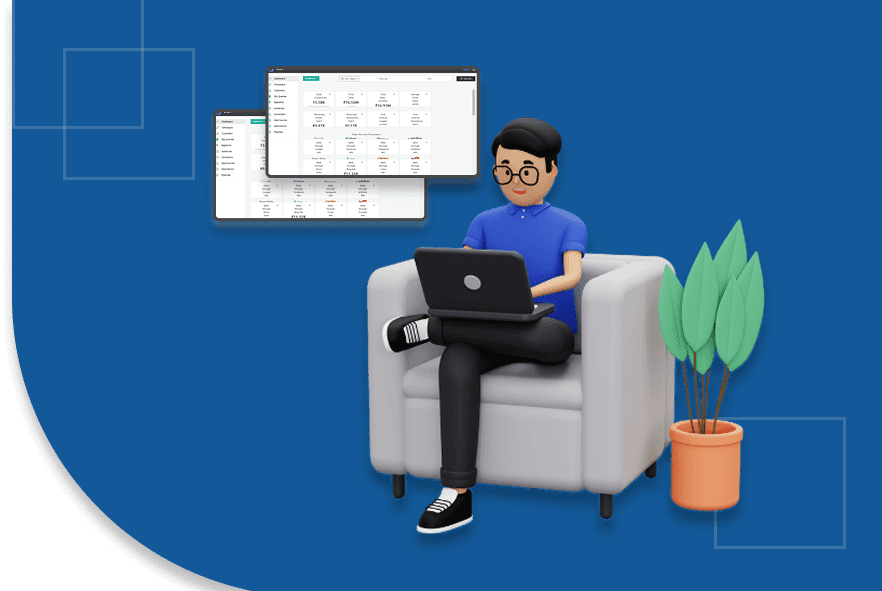Customer Acquisition: Strategies and Guide for 2025
How well do you understand your customers?
In the U.S., businesses are increasingly challenged to connect with consumers who are more discerning, privacy-conscious, and selective about where they spend their money. It has been seen that 42% of online shoppers used AI-powered chatbots during the holiday season, highlighting the growing role of technology in shaping purchasing decisions.
Moreover, mobile commerce continues to rise, with mobile devices accounting for 53% of online spending during the holiday season, totaling approximately $128.1 billion.
These shifts underscore the importance of adapting your customer acquisition strategies to meet evolving expectations. Embracing privacy-compliant, data-driven approaches is no longer optional; it's a necessity for building trust and driving growth.
TL;DR
- Customer acquisition in 2025 focuses on privacy, personalized experiences, and smooth cross-platform interactions.
- Privacy-first strategies are essential due to regulations like GDPR and CCPA, which require strict compliance.
- Top strategies include AI-driven personalization, sustainable marketing, and immersive brand experiences.
- Key metrics like CAC, conversion rates, and CLV help assess and improve your acquisition efforts.
What is Customer Acquisition?
Customer acquisition is the process of attracting new customers and converting them into loyal, paying clients. The importance of adopting a customer acquisition strategy that prioritizes privacy and data security will never be greater. Countries, particularly in North America and Europe, have ramped up enforcement of data privacy laws such as GDPR and CCPA. High-profile fines against companies like Meta for breaching user privacy have made businesses more aware of the need for compliance in their customer acquisition strategies.
As a result, using privacy-compliant tools and cookieless advertising solutions is essential to acquire and engage customers while respecting their privacy. Your customer acquisition strategy must adapt to these changes, ensuring you build trust while leveraging valuable insights to drive growth.
Next, we’ll explore how the landscape of customer acquisition is evolving, highlighting new challenges and opportunities in the market.
The Evolving Landscape of Customer Acquisition

Many aspects will shape the future of customer acquisition for you. To engage today’s tech-savvy consumers, providing seamless experiences across multiple channels is key. By focusing on transparency, sustainability, and ethical practices, you can build trust with your audience. Additionally, using interactive and immersive content, like AR or VR, will help you boost engagement and increase conversion rates.
Here are some fresh insights to guide your approach:
- AI-Powered Predictive Analytics: Leverage AI tools to predict customer behavior, allowing you to tailor marketing efforts proactively.
- Real-Time Customer Insights: Use data-driven platforms to monitor customer behavior in real time, adjusting your strategies instantly.
- Value-Based Marketing: Focus on creating value for customers through educational content, helpful resources, and meaningful engagement.
- Sustainable Practices: Show your commitment to sustainability, as consumers increasingly prioritize brands that align with their values.
By taking up these strategies, you’ll create more meaningful connections with customers while staying ahead in a rapidly evolving market.
As we move forward, let’s consider the critical steps and strategies that will help you successfully acquire customers in today’s fast-paced digital landscape.
How Do You Acquire Customers?
Acquiring customers requires a strategic approach that focuses on privacy, personalization, and seamless experiences. As a business, you must ensure that your customer acquisition tactics align with modern expectations, such as transparency and data security. Here are some of the methods:
- Personalization and AI InsightsAcquiring customers in 2025 requires a strategic approach that focuses on privacy, personalization, and seamless experiences. As a business, you must ensure that your customer acquisition tactics align with modern expectations, such as transparency and data security. By embracing cookieless advertising solutions, you can stay compliant with data privacy regulations while still gathering valuable insights to enhance your marketing efforts.
- Utilize First-Party DataTo acquire customers effectively, you need to implement personalized strategies that address your target audience's specific needs. Using first-party data, powered by AI and machine learning, will help you understand your customers' behaviors and preferences. Tailoring your messaging and offers based on these insights will create stronger connections with potential customers, increasing the likelihood of conversions.
- Omnichannel EngagementAn omnichannel approach is also crucial in today’s market. Customers engage with brands through various platforms, including websites, social media, emails, and more. By providing consistent, seamless experiences across all touchpoints, you can nurture potential customers and guide them through their journey with your brand.
- Building Trust with TransparencyLastly, building trust through ethical marketing practices is key. As data privacy concerns rise, customers are increasingly seeking brands that are transparent about how they collect and use data. Prioritize transparency in your marketing efforts to ensure customers feel secure when interacting with your business.
At this point, let's look into some key metrics that help track and measure the success of your customer acquisition strategy.
Customer Acquisition Metrics: Key to Measuring Success

Measuring the effectiveness of your customer acquisition strategy is essential for refining your efforts and ensuring the best results. Tracking the right metrics allows you to understand what's working, adjust strategies, and ensure that your resources are being used effectively. Here’s a closer look at the key customer acquisition metrics to track, along with examples to help you understand their importance:
1. Customer Acquisition Cost (CAC)
Customer Acquisition Cost (CAC) is the total amount spent to acquire a new customer. This includes marketing expenses, sales team costs, and other resources used in attracting and converting leads. Understanding CAC helps you determine whether your marketing efforts are financially sustainable.
Formula: CAC = Total Marketing + Sales Costs / Number of Customers Acquired
Example: If you spend $10,000 on marketing and acquire 100 new customers, your CAC is $100. This means each new customer costs you $100 to acquire.
Why It Matters: A high CAC suggests you may be overspending, while a low CAC means your resources are being used efficiently. The goal is to reduce CAC while increasing customer volume.
Optimization Tip: Target the right audience and refine your marketing efforts to lower CAC and ensure efficient spending.
2. Conversion Rate
Conversion rate measures the percentage of visitors who take a desired action, such as making a purchase or signing up for a service. This metric directly reflects how well your marketing and sales strategies persuade potential customers.
Formula: Conversion Rate = (Conversions / Total Visitors) * 100
Example: If 1,000 people visit your website and 50 make a purchase, your conversion rate is 5%. This tells you how effective your site and offers are at turning visitors into customers.
A low conversion rate could indicate problems with your landing page design, user experience, or messaging. Improving this rate will directly impact your ability to acquire customers.
Optimization Tip: Simplify your site’s checkout process, improve product descriptions, and provide personalized offers to boost conversion rates.
3. Lead-to-Customer Ratio
This metric tracks how many of your leads convert into paying customers. It helps evaluate the quality of your leads and the efficiency of your sales process.
Formula: Lead-to-Customer Ratio = Number of Customers / Number of Leads
Example: If you generate 1,000 leads and 200 become customers, your lead-to-customer ratio is 20%. This means 20% of your leads are turning into paying clients.
A high ratio indicates your sales team is effective in closing deals. A low ratio suggests you may need to improve lead nurturing or the quality of your leads.
Optimization Tip: Focus on better qualifying leads and nurturing them more effectively to improve this ratio.
4. Customer Lifetime Value (CLV)
Customer Lifetime Value (CLV) helps you understand the total revenue a customer is expected to bring over their entire relationship with your brand. This metric is critical in determining how much you should invest in acquiring new customers.
Formula: CLV = Average Purchase Value Average Purchase Frequency Average Customer Lifespan
Example: If a customer spends $50 per purchase, buys 4 times a year, and stays for 3 years, their CLV would be $600. This shows how much value a customer brings over time.
CLV helps you assess whether your acquisition costs are worth the long-term value a customer brings. It guides your marketing budget allocation.
Optimization Tip: Implement retention strategies, loyalty programs, and cross-sell opportunities to increase CLV.
5. Churn Rate
Churn Rate measures the percentage of customers who stop doing business with your company over a specific period. It’s an important metric for understanding customer retention.
Formula: Churn Rate = (Customers at Start of Period - Customers at End of Period) / Customers at Start of Period * 100
Example: If you start the month with 500 customers and end with 450, your churn rate is 10%. This means 10% of your customers left during that time.
A high churn rate indicates issues with your product or service, customer support, or engagement. Reducing churn is vital for maintaining steady growth.
Optimization Tip: Address customer feedback, provide excellent support, and improve customer satisfaction to reduce churn.
6. Customer Retention Rate
Customer retention is the ability to keep customers over time. The retention rate indicates how well you are maintaining your existing customer base after acquisition.
Formula: Retention Rate = (Number of Customers at End of Period - Number of New Customers Acquired During Period) / Number of Customers at Start of Period * 100
Example: If you start the quarter with 1,000 customers, acquire 200 new ones, and end the quarter with 1,150 customers, your retention rate is 80%. This means 80% of your existing customers stayed with you.
High retention rates indicate that customers are satisfied and loyal. Retained customers are more likely to make repeat purchases and refer others.
Optimization Tip: Focus on improving customer experience and engaging with customers regularly to increase retention.
7. Time to Payback CAC
Time to Payback CAC tells you how long it takes for the revenue from a new customer to cover the cost of acquiring them. This is an important metric for understanding the financial efficiency of your acquisition strategy.
Formula: Time to Payback CAC = CAC / Monthly Revenue per Customer
Example: If your CAC is $200 and your average customer spends $20 per month, it will take you 10 months to recover the cost of acquiring that customer.
A shorter payback period means you can quickly reinvest in acquiring more customers. A longer period means you need to rethink your strategy to speed up the process.
Optimization Tip: Accelerate customer spending through promotions, upsells, and additional services to shorten the payback period.
By tracking these key customer acquisition metrics, you can make smarter decisions, optimize your marketing strategies, and ultimately acquire customers more effectively. From here, we’ll look at the most effective customer acquisition strategies for 2025 that will keep you ahead of the curve.
Top 7 Customer Acquisition Strategies for 2025

The future of customer acquisition isn’t just about attracting new customers—it’s about creating meaningful, personalized experiences that build trust and foster long-term relationships. To succeed, you’ll need to adapt to changing consumer behaviors, prioritize ethical marketing practices, and use technology to offer seamless experiences across channels.
Here are seven key strategies to help you acquire customers effectively in 2025:
1. Hyper-Personalization with AI
Usining AI and machine learning to create uniquely tailored experiences, product recommendations, and messaging based on real-time customer data. This goes beyond simple personalization; it’s about delivering contextual relevance that makes your customers feel understood. By using AI, you can adapt content, offers, and product suggestions to each individual’s behavior and preferences.
- Customer Segmentation: Use AI to analyze customer behavior and segment them for personalized targeting.
- Real-Time Adjustments: Automatically adapt offers and content based on real-time customer actions.
- Increased Engagement: Personalized experiences lead to more engagement, higher conversions, and improved customer retention.
This approach not only helps you attract customers but also ensures you keep them coming back, boosting your ROI.
Ingest IQ’s event streaming and custom event tracking enable real-time behavioral segmentation and adaptive personalization without third-party cookies.
2. Seamless Omnichannel Engagement
Create a unified and consistent customer journey across every touchpoint, including websites, social media, apps, emails, and offline channels. You need to integrate all platforms to work together seamlessly. By offering a consistent experience across various channels, you reduce friction in the customer journey and ensure your brand is easily accessible.
- Integrated Systems: Ensure your systems across all platforms share customer data for a smooth experience.
- Cross-Platform Consistency: Deliver consistent messaging across channels like email, social media, and your website.
- Convenient Experience: Allow customers to switch between platforms without losing context, making it easier for them to engage.
This omnichannel strategy will increase customer satisfaction and improve your customer acquisition efforts.
Ingest Labs’ centralized data management and 100+ integrations synchronize user data and messaging across all digital channels. Real-time data orchestration ensures seamless experiences from web to mobile to offline touchpoints.
3. Sustainability and Ethical Marketing
Consumers today are more conscious of the environmental and social impact of their purchases. By prioritizing sustainability and ethical practices, you can attract a growing segment of eco-conscious customers. Communicate your commitment to sustainability and social responsibility clearly in your marketing messages.
- Transparency: Be clear about your company’s sustainability practices and the impact of your products.
- Eco-Friendly Products: Offer products that are environmentally friendly and ethically sourced.
- Brand Loyalty: Customers who align with your values are more likely to stay loyal and recommend your brand.
Incorporating sustainability into your customer acquisition strategy can drive long-term growth by appealing to value-driven consumers.
Ingest Labs’ compliance controls and audit trails in the Tag Manager ensure transparent, privacy-first data practices and support ethical marketing initiatives. Use reporting tools to showcase your compliance and sustainability metrics.
4. Experiential Marketing
Design engaging, multi-sensory experiences that create emotional connections with your audience. Whether through interactive installations, virtual reality, or pop-up events, these immersive experiences increase brand memorability and encourage customers to share their experiences. By offering unique, emotional encounters with your brand, you create lasting impressions that drive customer loyalty.
- Interactive Tech: Use VR and AR to offer immersive, hands-on experiences that engage users deeply.
- Event Marketing: Host workshops or pop-up events to directly engage with customers in an authentic way.
- Memorable Experiences: Create experiences that customers want to share with their networks, increasing organic brand awareness.
Experiential marketing helps you forge strong emotional ties with customers, making them more likely to convert and stay loyal.
Event IQ’s custom event tracking captures every interaction during experiential campaigns, feeding real-time insights into your analytics. Use Tag Manager’s live debugging to monitor engagement and optimize experiences as they happen.
5. Community-Led Growth and User-Generated Content
Building communities around your brand creates a sense of belonging for your customers. Encourage the creation and sharing of user-generated content, such as reviews, testimonials, and social media posts, to increase trust and engagement. This social proof is incredibly powerful in convincing new customers to take the leap and purchase from your brand.
- Encourage Engagement: Actively engage with your community to foster stronger connections.
- Incentivize Content Creation: Offer incentives like discounts or recognition for user-generated content.
- Utilize Social Proof: Showcase customer reviews, testimonials, and photos to build credibility and trust.
By fostering a community of brand advocates, you create a network that helps fuel organic growth and customer acquisition.
Use Ingest ID’s cross-device identity resolution to unify community engagement data and attribute user-generated content accurately. Real-time alerts notify you when new content or advocacy spikes occur.
6. Voice Search and Conversational AI Optimization
As voice search continues to grow in popularity, optimizing your content for voice search is becoming increasingly important. Use conversational language and target long-tail keywords to improve your visibility on virtual assistants like Alexa and Siri. Additionally, integrating AI-powered chatbots and assistants into your strategy can streamline the lead qualification process and provide real-time support.
- Optimize for Voice: Focus on natural, conversational keywords to improve discoverability via voice search.
- AI Chatbots: Implement AI chatbots to engage customers immediately and guide them through the sales process.
- Instant Support: Provide quick responses to common customer questions, improving satisfaction and conversion rates.
Voice search and conversational AI will help you stay relevant in a rapidly evolving digital environment and enhance customer acquisition.
Ingest IQ’s server-side tagging and data streaming capture voice and chatbot interactions across platforms. Feed this data into analytics or AI models to refine conversational experiences and optimize for voice-driven discovery.
7. Data-Driven Decision Making and Optimization
Utilize advanced analytics tools and predictive insights to continuously optimize your customer acquisition strategies. Use data to monitor campaign performance, analyze customer behavior, and make adjustments in real-time. By focusing on data-driven decision-making, you can reduce customer acquisition costs (CAC) while maximizing your return on investment (ROI).
- Predictive Analytics: Use AI and data analytics to predict customer behavior and adjust your acquisition tactics.
- Real-Time Optimization: Continuously test and adjust messaging, targeting, and channels for optimal results.
- Campaign Insights: Use data to determine which strategies are working and allocate resources more efficiently.
Event IQ’s real-time analytics and Tag Manager’s reporting suite deliver actionable insights for rapid optimization. Use automated alerts to detect anomalies, ensuring campaigns remain efficient and data-driven.
By adopting a data-driven approach, you ensure that your customer acquisition efforts are constantly evolving and improving, delivering higher-quality leads at a lower cost. Now, let's examine the tools and platforms available to help you implement these approaches effectively.
Tools and Platforms to Enhance Your Customer Acquisition Strategy
To achieve successful customer acquisition, you need the right set of tools that not only streamline your marketing efforts but also ensure privacy compliance and enhance user experience. Below, we explore several essential platforms, including Ingest Labs, that can optimize your customer acquisition strategies while adhering to privacy-first principles.
1. Ingest Labs: Privacy-First Data Platform
Ingest Labs is a powerful platform that helps businesses manage and optimize their customer acquisition efforts without relying on third-party cookies. With its emphasis on privacy, performance, and compliance, Ingest Labs offers a suite of tools designed to collect and analyze data across websites and mobile apps.
- Privacy & Compliance: Ingest Labs ensures that your customer acquisition processes adhere to global data privacy laws like GDPR and CCPA.
- Centralized Data Management: The platform provides a centralized hub where you can monitor and optimize all digital data processes, including tracking tags and pixels.
- Integrations: With over 100 built-in integrations and a no-code interface, Ingest Labs connects seamlessly with your existing marketing and analytics tools, allowing for smooth data flows across platforms.
- Server-Side Tracking: By moving tracking scripts to the server side, Ingest Labs reduces browser load, enhancing website performance while ensuring data privacy.
These features make Ingest Labs a comprehensive platform for organizations focused on data-driven customer acquisition while ensuring user privacy and compliance.
2. Google Analytics: Powerful Data Insights
Google Analytics remains one of the most widely used platforms for tracking customer interactions and optimizing marketing strategies. It provides deep insights into customer behavior, helping businesses identify which acquisition channels and tactics are most effective.
- User Behavior Tracking: Track how users interact with your website and identify opportunities to improve conversion rates.
- Custom Reports & Dashboards: Create tailored reports and dashboards to monitor key customer acquisition metrics, such as traffic sources and goal completions.
- Cross-Device Tracking: Understand how customers interact with your brand across different devices, allowing you to optimize the user journey.
While Google Analytics is excellent for monitoring web traffic and understanding customer behavior, integrating it with privacy-compliant solutions like Ingest Labs helps safeguard customer data.
Final Thoughts
Customer acquisition is becoming more complex, with businesses needing to adapt to shifting consumer expectations, stricter privacy regulations, and the growing demand for personalized experiences. As competition intensifies, organizations must focus on leveraging data-driven strategies that not only capture new customers but also build lasting relationships with them. Embracing tools that provide privacy-compliant solutions and real-time insights will be essential in driving acquisition success.
Ingest Labs stands out as a comprehensive solution for modern customer acquisition challenges. With products like Ingest IQ, Ingest ID, and Event IQ, Ingest Labs offers powerful tools that help you track customer behavior across channels, enhance conversions, and ensure compliance with global privacy standards. From server-side tracking and cross-channel marketing to data orchestration and customer profiling, Ingest Labs enables businesses to deliver tailored, privacy-first customer experiences at scale. By integrating these solutions into your customer acquisition strategy, you can optimize marketing efforts and drive more meaningful engagements with your audience.
Ready to optimize your customer acquisition strategy with privacy-compliant, data-driven solutions?
Contact us today to explore how Ingest Labs' cookieless advertising solutions can help you drive conversions and build lasting customer relationships.
FAQ
1. What is customer acquisition?
Customer acquisition is the process of attracting and converting new customers into paying clients.
2. Why is customer acquisition important?
It drives business growth by bringing in new customers and expanding your customer base.
3. How do I measure customer acquisition success?
Use metrics like Customer Acquisition Cost (CAC), conversion rate, and Customer Lifetime Value (CLV).
4. What strategies improve customer acquisition?
Personalizing experiences, using multi-channel marketing, and focusing on privacy compliance.
5. How do privacy regulations impact customer acquisition?
They require businesses to handle customer data responsibly, ensuring trust and legal compliance.






